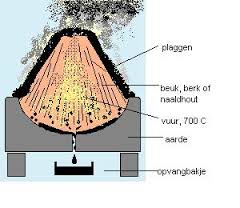Tar is a dark, viscous, tough substance with a characteristic odor. Wood tar was used as glue, and to sustain rope, leather and wood to protect it against rot.
Wood tar
 Wood tar is obtained by (dry) heating vegetable material such as wood, coal,.. without admitting air. The volatile gases which arise hereby condense by cooling to a tar. The portion of the timber that is left after this operation is charcoal.
Wood tar is obtained by (dry) heating vegetable material such as wood, coal,.. without admitting air. The volatile gases which arise hereby condense by cooling to a tar. The portion of the timber that is left after this operation is charcoal.
Wood tar is approximately one eighth of the amount of wood from which it is recovered. In Finland they win in out stumps of conifers.
Wood tar (brown tar) is now allowed again because it has hardly PAHs.
Most of Polycyclic Aromatic Hydrocarbons are very damaging, they are toxic, carcinogenic and / or poorly degradable.
Take a small pot to catch tar. Put on this a large pot with holes in the bottom. Fill it with wood. Put them in a pit. Seal the lid and the connection between the pot with some clay. Heat around the upper pot for 3 hours with a fire. For dry distillation 700⁰C is needed. The gases condense in the cold lower pot as wood tar.
In the north, large funnels are made against a hill coated with clay and wood compactly stacked on a wooden lattice and closed. At the bottom tar is collected via a tube, 25 to 35 kg per tonne of dry wood.
Suitable woods are mainly resinous pine (Pinus sylvestrus), cedar, but also birch (bark).
Brown tar is also used to treat hoof rot.
Tar from your hands can be remove by rubbing about with cleavers.
